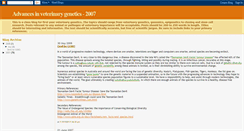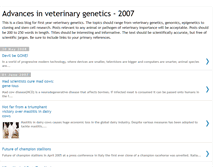Advances in veterinary genetics - 2007
OVERVIEW
BIOC1011-2007.BLOGSPOT.COM RANKINGS
Date Range
Date Range
Date Range
LINKS TO WEB SITE
WHAT DOES BIOC1011-2007.BLOGSPOT.COM LOOK LIKE?



BIOC1011-2007.BLOGSPOT.COM HOST
SERVER OS AND ENCODING
I found that this domain is operating the GSE server.PAGE TITLE
Advances in veterinary genetics - 2007DESCRIPTION
This is a class blog for first year veterinary genetics. The topics should range from veterinary genetics, genomics, epigenetics to cloning and stem cell research. Posts relevant to any animal or pathogen of veterinary importance will be acceptable. Posts should be 200 to 250 words in length. Titles should be interesting and informative. The text should be scientifically accurate, but free of scientific jargon. Be sure to include links to your primary references.CONTENT
This web page bioc1011-2007.blogspot.com states the following, "Advances in veterinary genetics - 2007." We saw that the webpage said " In a world of progressive modern technology, where devices are smaller, televisions are bigger and computers are smarter, animal species are becoming extinct." It also said " The Tasmanian Devil, is very close to this dangerous line. A disease discovered in the late 90s called the Tasmanian Devil Facial Tumour Disease. The tumour is a contagious cancer cell line. Among the species, the amount of genetic variability. 8221; to save the genetic material in a suspended animation, s."SEEK SIMILAR DOMAINS
Thursday, March 3, 2011. Assignment 2 due 11 March 2011. What is insulin and why is it important in carbohydrate metabolism? Include the structure of insulin in your work. Everything should fit in one page. Monday, February 14, 2011. Someone hacked into our account and locked me out. So I have decided to open another account and just e-mail you the notes from there. And I will send you the notes. Wednesday, February 2, 2011.
Post comments and links relating to interesting genetic findings, announcements, papers and seminars to share them with your classmates. Your literature review abstracts will be posted here as well. Link between NNK and induces DNMT1. Review of induction of flowering by DNA demethylat. Is Epigenetic Status of Cancer Cells Influence Tel. Disturbs of brain development can lead to adult to. Do you have the X-Factor? Their experim.
Tuesday, October 4, 2011. Finding the Gene Coding Regions in a DNA sequence. You have just isolated your DNA from your sample and want to find out which genes will be encoded in the sequence. 1 Find the ORF regions.
К сожалению, по вашему запросу ничего не найдено. Пожалуйста, убедитесь, что запрос введен корректно или переформулируйте его. Пожалуйста, введите более двух символов. Крем для кожи вокруг глаз. Мази и гели от боли.
ÁèîÊàëüöèé äëÿ ñíèæåíèÿ óðîâíÿ ñàõàðà â êðîâè. Íà ðóáëè êàê ïîÿâèëèñü èíôîðìàöèÿ.